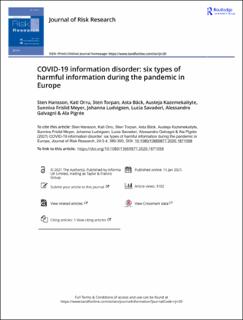| dc.contributor.author | Hansson, Sten | |
| dc.contributor.author | Orru, Kati | |
| dc.contributor.author | Torpan, Sten | |
| dc.contributor.author | Bäck, Asta | |
| dc.contributor.author | Kazemekaityte, Austeja | |
| dc.contributor.author | Meyer, Sunniva Frislid | |
| dc.contributor.author | Ludvigsen, Johanna | |
| dc.contributor.author | Savadori, Lucia | |
| dc.contributor.author | Galvagni, Alessandro | |
| dc.contributor.author | Pigrée, Ala | |
| dc.coverage.spatial | Norway, Oslo | en_US |
| dc.date.accessioned | 2023-06-20T11:33:18Z | |
| dc.date.available | 2023-06-20T11:33:18Z | |
| dc.date.created | 2021-05-19T18:05:51Z | |
| dc.date.issued | 2021-01-15 | |
| dc.identifier.citation | Journal of Risk Research. 2021, 24 (3-4), 380-393. | en_US |
| dc.identifier.issn | 1366-9877 | |
| dc.identifier.uri | https://hdl.handle.net/11250/3072283 | |
| dc.description | {Sten Hansson and Kati Orru and Sten Torpan and Asta Bäck and Austeja Kazemekaityte and Sunniva Frislid Meyer and Johanna Ludvigsen and Lucia Savadori and Alessandro Galvagni and Ala Pigrée}, {COVID-19 information disorder: six types of harmful information during the pandemic in Europe}, {Journal of Risk Research}, {24}, {3-4}, {380-393}, {2021}, {Routledge}, {10.1080/13669877.2020.1871058}, { https://doi.org/10.1080/13669877.2020.1871058} | en_US |
| dc.description.abstract | The outbreak of a novel coronavirus disease COVID-19 propelled the creation, transmission, and consumption of false information – unverified claims, misleading statements, false rumours, conspiracy theories, and so on – all around the world. When various official or unofficial sources issue erroneous, misleading or contradicting information during a crisis, people who are exposed to this may behave in ways that cause harm to the health and well-being of themselves or others, e.g., by not taking appropriate risk reducing measures or blaming or harassing vulnerable groups. To work towards a typology of informational content that may increase people’s vulnerability in the context of the coronavirus pandemic, we explored 98 instances of potentially harmful information that spread in six European countries – France, Italy, Norway, Finland, Lithuania, and Estonia – between March and May 2020. We suggest that during the pandemic, exposure to harmful information may have made people more vulnerable in six ways: (1) by discouraging appropriate protective actions against catching/spreading the virus, (2) by promoting the use of false (or harmful) remedies against the virus, (3) by misrepresenting the transmission mechanisms of the virus, (4) by downplaying the risks related to the pandemic, (5) by tricking people into buying fake protection against the virus or into revealing their confidential information, and (6) by victimising the alleged spreaders of the virus by harassment/hate speech. The proposed typology can be used to guide the development of risk communication plans to address each of these information-related vulnerabilities. | en_US |
| dc.language.iso | eng | en_US |
| dc.publisher | Taylor and Francis Group [Commercial Publisher] Routledge [Imprint] | en_US |
| dc.rights | Attribution-NonCommercial-NoDerivatives 4.0 Internasjonal | * |
| dc.rights.uri | http://creativecommons.org/licenses/by-nc-nd/4.0/deed.no | * |
| dc.subject | Risk communication | en_US |
| dc.subject | vulnerability | en_US |
| dc.subject | infodemic | en_US |
| dc.subject | misinformation | en_US |
| dc.subject | disinformation | en_US |
| dc.subject | coronavirus | en_US |
| dc.title | COVID-19 information disorder: six types of harmful information during the pandemic in Europe | en_US |
| dc.type | Journal article | en_US |
| dc.type | Peer reviewed | en_US |
| dc.rights.holder | © 2021 The Author(s). Published by Informa UK Limited, trading as Taylor & Francis Group | en_US |
| dc.description.version | publishedVersion | en_US |
| cristin.ispublished | true | |
| cristin.fulltext | original | |
| cristin.qualitycode | 1 | |
| dc.identifier.doi | 10.1080/13669877.2020.1871058 | |
| dc.identifier.cristin | 1910882 | |
| dc.source.journal | Journal of Risk Research | en_US |
| dc.source.volume | 24 | en_US |
| dc.source.issue | 3-4 | en_US |
| dc.source.pagenumber | 380-393 | en_US |
| dc.relation.project | EU – Horisont Europa (EC/HEU): 833496 | en_US |

